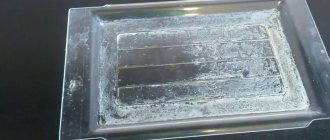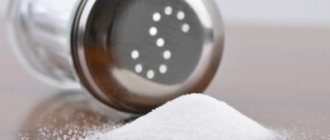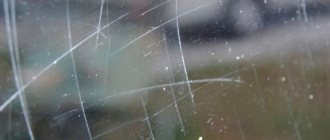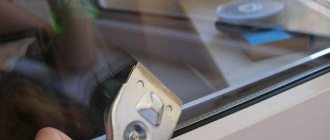How to remove using folk remedies?
The problem of limescale is directly related to the quality of tap water . The salts it contains in large quantities begin to deposit on the glass over time. To dissolve them, simple improvised means can be used.
Vinegar
Acetic acid can be used to remove limescale. Regular table vinegar undiluted or concentrated vinegar essence with the addition of water will do.
Procedure:
Pour 1 glass of water into the prepared container.- Add 1 tbsp. l. essences.
- Stir.
- Apply the product using a napkin or spraying from a spray bottle.
- Leave for 15-20 minutes.
- The area with tinder coating.
- The glass is washed off with water and wiped dry.
After treatment with vinegar, a specific odor may remain.
Ammonia
Ammonia is a fairly common remedy for treating dirt and various stains. It is also suitable for removing lime from glass.
For processing, you need to prepare a solution from the following ingredients:
- a glass of warm water;
- 20 ml. ammonia.
The components are mixed and used to wipe off plaque. For best results, it is recommended to keep the composition on the glass for 10-15 minutes.
Ammonia has a specific pungent odor, so it is advisable to carry out the treatment with good ventilation.
Toothpaste
Toothpaste will help remove limescale in small areas. To treat, the paste is squeezed onto a damp brush (or an old toothbrush) and rubbed into problem areas. After 5-10 minutes you will need to repeat the cleaning. After this, the composition is washed off with water and the glass is wiped dry.
Lemon acid
For exposure, it is necessary to prepare a solution from the following components:
- 1 glass of water;
- 1 packet of citric acid.
It is convenient to apply the solution to a large area using a sprayer. After the product has been kept on the glass for a quarter of an hour.
After this, the glass is washed using warm water. It is advisable to use warm water to create the solution - this will increase the cleaning efficiency.
Hydrogen peroxide
The use of pharmaceutical peroxide in the national economy is widespread. It is enough to apply the product on a napkin and wipe the areas affected by lime , moisturizing them well. After 15 minutes, the glass is washed with water and wiped dry.
How to clean different devices and surfaces?
Depending on the type of heating device, the methods for removing limescale will differ.
From the iron
To remove scale from the iron, you will need a cleaning solution (you can use soda, citric acid, vinegar and other products), which is poured into the water tank.
The iron is heated, lowered with the sole down, holding it suspended. Using the steam function, rinse the device until the cleaning solution is completely removed. A basin is used to collect liquid with salt deposits.
Read more here.
From the water heater
To clean the boiler, you need to drain all the water from it and close the water supply taps. Then remove the heating element (to do this you will need to unscrew the lid). The heating element is placed in a cleaning solution, for example, with acetic acid and left for 30-60 minutes.
It is necessary to ensure that during processing the composition does not get on the sealing rubber bands. When the scale has dissolved, the device is rinsed with clean water and returned to its place. Read more about removing scale from a water heater heating element here.
From the washing machine
To get rid of scale in your washing machine, it is better to use specialized detergents, strictly following the instructions. This is the only way to guarantee that an expensive device will not fail.
If a powdered product is used for cleaning, it is poured into the drum or into the washing powder section. The liquid is poured into the rinse aid reservoir. All that remains is to start the wash cycle (without clothes) and wait for it to complete.
This and this article will tell you about descaling a washing machine.
From the kettle
The easiest way to clean a kettle is. The washing solution is poured into it, brought to a boil and left to act for 30-60 minutes.
Then you need to drain the composition with the scale dissolved in it. Before using the device again, rinse it thoroughly. The water is drained several times.
When starting cleaning, you must warn all household members that there is a caustic solution in the kettle. This will avoid accidental poisoning. Read more about ways to descale a kettle here.
From thermopot
Thermopot is an improved alternative to an electric kettle, but it is not protected from the formation of limescale. You can cope with the problem using improvised means (vinegar, soda, acid) or household chemicals.
Pour the selected solution into the container, bring it to a boil, cool and drain. If necessary, the procedure is repeated. Read more here.
From a coffee machine
To descale a coffee machine, you need to pour the solution into the water tank and put the device into operation. When the liquid boils, turn off the device, but do not drain it immediately. The composition needs time to dissolve limescale. This will take about half an hour.
After cleaning is completed, the device must be turned on by running plain water through it. You can make coffee only after rinsing.
To remove scale, use both improvised means and professional household chemicals. Details are in this article.
From the pan
To remove scale from a pan, pour a cleaning agent into it, put it on fire and cover with a lid. When the liquid boils, turn off the gas.
After 30 minutes, the water must be drained. If necessary, gently rub the surface with a soft brush.
The pan, cleared of salts, is rinsed several times with clean water, after which it can be used as usual. Read more here.
From a steam generator
To remove scale from a steam generator, use citric or acetic acid. Household cleaners do a good job.
To remove salt deposits proceed as follows:
- drain water from the boiler;
- pour the prepared solution into it;
- close the valve;
- turn on the device to maximum heat;
- iron unnecessary fabric, constantly supplying steam;
- turn off the device and allow it to cool;
- drain the remaining liquid and rinse the tank.
If the device is heavily clogged, splashes will fly out of it.
You need to work carefully so as not to get scalded.
From a humidifier
Instructions for descaling the humidifier:
- Drain the water.
- Remove dirt with a soft cloth.
- Pour an acid-based cleaning solution into the reservoir.
- Leave to act for 3-5 hours.
- Rinse all elements with clean water.
You cannot connect the device to the network while the solution is in it. It is recommended to use non-aggressive compounds, for example, citric acid.
How to clean the surface with special preparations?
Thanks to a carefully selected composition, special household chemicals allow you to quickly and effectively deal with limescale deposits, as well as other contaminants. It is better to give preference to compositions designed specifically for processing glass.
Glutoclean spray
Shower cabin care product removes rust and limescale deposits. When treated with the product, a water-repellent effect is created .
The spray can be applied not only to glass doors, but also to plastic and aluminum. Due to the creation of a water-repellent coating, the treatment effect is long-lasting and consumption is economical. Price – from 700 rubles.
Meine Liebe
An environmentally friendly, biodegradable product from TM Meine Liebe includes fruit acids. These substances allow you to efficiently remove limescale, fungus, mold, and soap stains. The product is safe for health and can be used to care for smooth, shiny surfaces.
The spray does not leave streaks behind . After application, it is recommended to wipe it off until completely dry. The average price is from 200 rubles.
Cif
Cif spray allows you to achieve clean glass in a matter of seconds. When applied, it removes limescale and soap deposits. The composition contains non-ionic surfactants - up to 15%. The average price is from 220 rubles.
Useful tips
Cleaning glassware will be more efficient if you use a few tips:
- Always remove jewelry to avoid scratching items.
- Rinse in a saline solution to prevent streaking and enhance shine.
- Try to wash dishes with purified water.
- Avoid using washing powder and glass and kitchen detergents.
- Make it a habit not to hoard kitchen utensils, but to wash them right away.
- Soak plates if you cannot wash them.
- Wrap unnecessary dishes in paper and store them in boxes to avoid dust accumulation.
Caring for glass products does not cause much trouble. Glass is durable and resistant to external influences, so the choice of detergents is quite wide. But the appearance of severe contamination can be prevented if care and storage conditions are followed.
We use a steam generator
A steam cleaner is a universal cleaning tool . The device has many advantages. Among them are environmental friendliness, efficiency and ease of use.
Using a steam cleaner allows you to remove limescale without difficult scrubbing, even in hard-to-reach places. Some models of devices do not even leave condensation after treatment.
For mirrors and glass, a special nozzle and water distiller are used. As a result, the glass becomes clean even without the use of household chemicals.
If the glass is in poor condition, the treatment can be repeated. Or first apply a vinegar solution to the stained areas.
Best Home Remedies for Cleaning Limescale from Plastic
Everyone knows that limescale can be cleaned with acid. It is necessarily contained in ready-made cleaning products. You can make products for removing lime from plastic at home as follows:
- You need to take vinegar and water (3:1), mix them, apply the solution to the limescale, leave for 1 hour. After this, scrub the area thoroughly with a soft sponge and rinse the area with clean, cool water.
- It is necessary to prepare a solution of 30 grams of citric acid and 300 ml of water and wipe the contaminated area with it. After 20 minutes, remove any remaining lime with a soft sponge and rinse with plain water.
- A solution of 20 grams of ammonia and 200 ml of water has an excellent effect on limescale. It is used by applying it to the contaminated surface and waiting 30 minutes. Then the area is wiped and washed off with water.
If limescale has appeared recently and you were able to notice it in time, you can use any dishwashing detergent or washing powder. This type of plaque can be effectively treated with laundry bleach containing oxygen.
Features of removal from the shower stall
The appearance of limescale on the glass walls of shower cabins is associated with the regular ingress of water drops. Moisture that dries on its own on the walls leaves such a cloudy coating. Regular removal of water from glass after each shower will help slow down the formation of lime deposits.
In addition, the following measures must be taken:
- Regular ventilation of the cabin. To do this, the door must be left open.
- Carry out regular washing using suitable cleaning products (homemade or purchased).
For cleaning, you can use products made with vinegar, soda, laundry soap, toothpaste, and alcohol. Using a steam cleaner has a good effect.
A water-repellent coating will also help in the fight against lime . Hydrophobic agents are economical. They are applied to glass and distributed over the surface. As a result, incoming splashes of water simply flow off without leaving a trace.
When choosing a product to remove limescale, it is necessary to take into account the characteristics of the material on which the product may come into contact. For example, pallet, seals.
The frequency of general cleaning depends on the intensity of use and water quality. Typically, thorough washing should be carried out once a week, but if lime accumulates very quickly, then more often.
Remove stains and add shine
Any cleaning product will show good results only if it is used correctly. Frosted glass should be washed in the following order:
- Moisten the glass sheet with a soft cloth or sponge soaked in warm water.
- Using top-down movements, clean the dirt with a solution of laundry soap or dishwashing gel. Then remove the remaining product with warm water. If an industrial glass cleaning liquid is used, wipe the surface with crumpled paper or a dry cloth.
- Using the selected solution, old stains are removed if previous formulations have not dealt with them.
- Using a spray bottle, spray the glass with a solution of chalk or starch and leave it until dry.
- Use a dry cloth or crumpled newspaper to clean off the powder and rub the surface until it shines.
How to prevent lime deposits?
The formation of limescale is a very common problem; the following recommendations will help to significantly reduce the likelihood of its occurrence:
- After glass products come into contact with water, they must be dried. If possible, wipe dry. This will not only allow you to do general cleaning less frequently, but will also keep your glass surfaces in good condition.
- If the water is so hard that it becomes a problem, you can install a filter or use a water softener at the entrance to your home or apartment.
- When cleaning, it is necessary to use products that are active against limescale.
- Using sprays allows you to distribute the product evenly, making it faster and easier to clean the glass surface.
Regular care
Soap scum, like deposits of mineral salts from hard water, is difficult to remove, and therefore it is better to prevent the formation of such contaminants. To do this, it is enough to regularly perform a few simple manipulations:
- After using the shower stall, all its walls must be washed successively with hot and cold water.
- It is necessary to thoroughly rinse off traces of foam and soap, especially in hard-to-reach places, since it is most difficult to remove old dirt from there.
- After cleaning, all surfaces of the box should be wiped dry so that after drying, splashes of water do not leave salt deposits.
It will take about 15 minutes to complete these steps, but their result will be a significant improvement in caring for the shower stall. In addition, they will reduce the time required for general cleaning of the hydromassage box and help maintain its beautiful appearance.
Methods for cleaning bathtubs made of various materials
The choice of cleaning agent depends on the base material and coating of the bathtub. Substances intended for enamel whitening are not suitable for cleaning acrylic, and vice versa.
Acrylic
Such baths do not require complex maintenance. There are many ready-made chemicals available.
The instructions should state that the solution or powder is suitable for acrylic. The material is sensitive to strong acids.
You can try this popular method:
- The water drainage hole is closed. Fill the bath.
- Add a package of citric acid or 0.5 liters of 6% vinegar to the water.
- The solution is kept for 12 hours. After this, drain the water and wipe the inner surfaces of the bath with a dry sponge.
A citric acid solution is good for preventing the appearance of a limescale layer and can be used continuously. The same remedy helps remove old plaque.
It is used like this:
- A packet of citric acid is dissolved in 0.5 liters of water. Soak a sponge in the liquid, which is used to treat the contaminated areas of the bath.
- After 5 minutes, remove the solution. If necessary, repeat the procedure.
- Wash the bathtub in the standard way.
Citric acid works well to remove limescale.
For severe contamination, use a more concentrated solution. A packet of acid is mixed with a glass of water.
Cast iron and enameled
An enameled cast iron bathtub is less sensitive than an acrylic one.
The enamel, which does not have cracks or chips, is resistant to strong acids. Metal elements that quickly lose their shine can be damaged. Such products as “Sillit”, “Toilet duckling”, “Domestos” are suitable for removing lime deposits.
Domestos is a popular plaque remover.
After reapplying the enamel, the bath requires more complex care. Aggressive cleaning agents must not be used. The methods used to clean acrylic plumbing fixtures will work.
How to clean whitewash from glass if it has already dried?
The ceiling was whitewashed and drops of whitewash fell on the glass (window and doors). How can I clean the whitewash off the glass now?
Whitewash can be chalk or lime.
Chalk whitewash is a little easier to remove from glass (windows, doors with glass).
If we are talking about whitewashing with lime, then at the beginning it is better not to rush with wet cleaning; there will be stains that will be difficult to remove.
Basic dirt can be removed with a dry rag, that is, just wipe the glass with a dry rag, in some cases you can use a scraper like this
Maybe even a blade.
I even used an ordinary wallpaper knife to remove lime from the glass; it’s better to insert a new blade, holding the knife almost parallel to the glass.
After the whitewash stains (the main ones) have been removed, you can wash the glass.
You can use factory-made detergents, or traditional ones.
We dilute ammonia and vinegar in warm water.
The proportions, per liter of water, half a tablespoon of ammonia and a tablespoon of vinegar, were mixed.
Next, wet the sponge in this solution and begin to wash the glass from top to bottom.
At the finish, wipe the glass with a dry (clean) rag.
Instead of a homemade solution, you can use a glass and mirror cleaner.
After removing the main layer of whitewash, turn the “nose” of the cleaner to the “spray” position and apply it to the surface from a distance of 200-250 mm from the glass.
We wait a little and wipe the glass with a clean (dry) rag.
If the stain cannot be completely removed, you can purchase a cleaning product that contains oxalic acid.
At the end, the glass can be washed with dishwashing liquid; it is better not to use abrasive detergents.
Source
Bringing beauty to the windows after whitewashing
The completion of finishing work at the installation site of metal-plastic windows is associated for the owner not only with relief, but also with a new, albeit final, stage of repair - cleaning. Stains, drips, and sticky areas do not at all decorate the new structure, so the question “How to get rid of dirt after installing a window?” always remains relevant.
Polyurethane foam is usually removed with special removers: Dimexide, White Spirit and others. Protective film - a hair dryer, a scraper, a stationery knife, industrial alcohol, wide tape. Water emulsion - soapy water. But how to clean whitewash from windows is often difficult. We hasten to give examples of effective disposal of this finishing material.
Say goodbye to whitewash marks easily!
Do not rush to wipe the windows with a wet rag - this will only result in dirty stains and new streaks, which you will have to fight with even longer. Dry whitewash is quickly removed from glass and window plastic with a dry rag. After you have dealt with the main stains, you can start cleaning the window. The profile lends itself to ordinary soapy water, glass to window cleaner or a homemade cleaning composition of water, ammonia and vinegar in the proportion of 2 liters of water, 1 tbsp. l. ammonia, 2 tbsp. l vinegar.
Cleaning lime whitewash will require a little more work. Try to carefully scrape it off the glass with a blade or a stationery knife. It is removed from the profile in one of the following ways:
- Cillit cleaner. Dilute Cillit with water in a 1:1 ratio, apply the liquid to the stains and rub with a hard cloth after a few minutes.
- Acidic solution. Mix a tablespoon of vinegar or citric acid into a bucket of water. Wash the profile with the solution.
- Salt. Use a glass of table salt in a bucket of water to wash off the whitewash.
- Sunflower oil. Add 100 g of vegetable oil to 10 liters of water. The oily composition will deal with stains in a jiffy or two, and greasy marks can be removed with dishwashing liquid.
Knowing how to clean whitewash from a window, you can safely plaster and whitewash slopes without worrying about the future state of the repair!
Source
What tools are needed for cleaning
First, let's list the items that will be useful in your work:
- large container for water (basin or bucket);
- soft sponge;
- a microfiber cloth (or a soft cloth that does not leave threads on the glass);
- glass scraper (a manual “mop” with a sponge on the edge - makes it easier to clean up water stains, preventing the appearance of streaks);
- spray bottle (to make it easier to apply detergent).
When you need to wash the entire window, and not a small fragment, you will still need a lot of water. To achieve perfect glass cleanliness, you cannot save water.
Personal experience
An example of the successful use of improvised substances is the use of 70% acetic acid. In addition, cotton pads and half a razor blade were prepared. To clean glass walls
- the discs were periodically wetted with acid;
- areas of contamination were wiped;
- After wiping, areas with heavy deposits were additionally cleaned with a blade.
The surface is quickly cleaned; in most cases, the blade turned out to be superfluous. After the procedure, the internal cavity must be thoroughly washed. The acid is concentrated, even a minimal amount can harm flora and fauna.
Important! Acetic acid of this concentration gives a strong odor, so it is advisable to clean it in a well-ventilated area.











